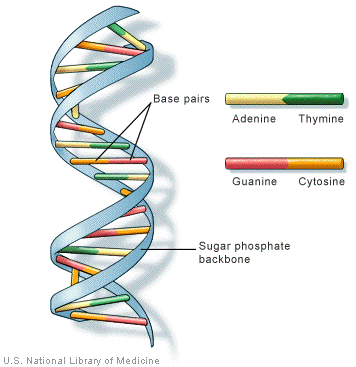Main Ideas
- Stands for Ribonucleic Acid
- Sugar is Ribose
- Nucleotide base contains Nitrogen bases, ribose sugar and a phosphate
- Has same nitrogen bases as DNA expect for Thymine replaced by Uracil
- Single stranded
- Three types of RNA are mRNA, tRNA and rRna
You may have heard of DNA, but it is not the same as RNA. RNA stands for Ribonucleic Acid. There are many differences between the two, however this project will focus on RNA. RNA comes in different shapes, but it is usually single stranded. It is a molecule with long chains of nucleotides. All nucleotides contain a nitrogen base, a sugar and a phosphate. The nitrogen bases that RNA has are Adenine, Uracil, Cytosine and Guanine. The sugar is ribose. The main purpose of RNA is that it is involved in protein synthesis. The RNA travels from the nucleus to the ribosomes. There are three types of RNA. They are mRNA(messenger RNA), tRNA(transfer RNA) and rRNA(ribosomal RNA). Messenger RNA starts out as DNA and goes through the process of transcription where it travels from the nucleus to the ribosomes. Transfer RNA decodes the mRNA sequence into amino acids. The Ribosomal RNA group the amino acids into protein chains.
I learned, from research, ribose sugar is more reactive because it has hydroxyl bonds, which are weak. Something that surprised me was that RNA has large groves that can be attacked by enzymes. I already knew that the four nitrogen bases of RNA are Adenine, Uracil, Cytosine and Guanine. RNA was something I already knew about from class. I like this objective because it is interesting that RNA looks very similar to DNA but is really different. RNA can be applied outside of biology because you can relate it to a code for different amino acids like code for a computer program.
Cashin-Garbutt, April. "What Is RNA?". News-Medical.net. N.p., 2016. Web. 12 Nov. 2016.
"Cite A Website - Cite This For Me". Scienceprofonline.com. N.p., 2016. Web. 12 Nov. 2016.
"Cite A Website - Cite This For Me". Image.slidesharecdn.com. N.p., 2016. Web. 12 Nov. 2016.
"Globalization, Biosecurity, And The Future Of The Life Sciences". N.p., 2016. Print.
Lodish, Harvey et al. "The Three Roles Of RNA In Protein Synthesis". Ncbi.nlm.nih.gov. N.p., 2016. Web. 12 Nov. 2016.



























